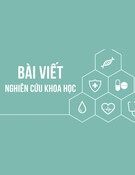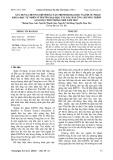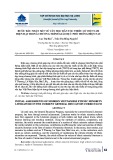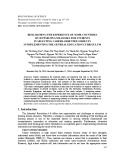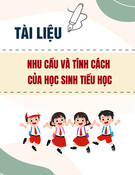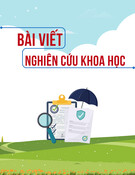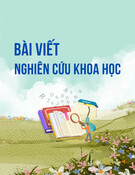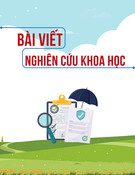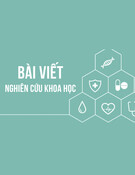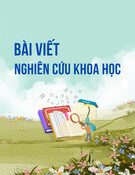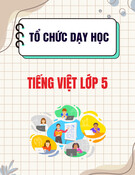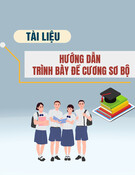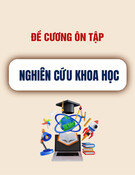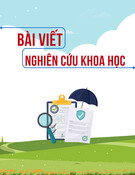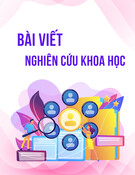
14
HNUE JOURNAL OF SCIENCE
Educational Sciences 2024, Volume 69, Issue 4, pp. 14-23
This paper is available online at https://hnuejs.edu.vn
DOI: 10.18173/2354-1075.2024-0159
EXPLORING EFL TEACHERS’ PERCEPTIONS OF NEW TEXTBOOK
UTILIZATION IN HIGH SCHOOL SETTINGS
Lam Ky Nhan* and Phuong Hoang Yen2
School of Foreign Languages, Can Tho University, Can Tho city, Vietnam
*Corresponding author: Lam Ky Nhan, email: kynhan0203@gmail.com
Received July 05, 2024. Revised August 25, 2024. Accepted September 10, 2024.
Abstract. This study investigates the perceptions of 43 English as a Foreign Language (EFL)
teachers regarding the benefits and challenges associated with using new textbooks in high
school settings. The research employs a combination of questionnaire surveys and semi-
structured interviews to explore teachers’ perceptions and experiences. It aims to uncover the
anticipated benefits of integrating new textbooks, such as providing updated content,
adopting more effective teaching methods, and enhancing student engagement. The study
also addresses key challenges, including resistance to change, inadequate teacher training,
and difficulties in aligning new materials with curricular goals. Additionally, it examines how
these perceptions influence teaching methods and curriculum implementation strategies. The
findings contribute to a deeper understanding of the role of new textbooks in EFL high school
environments, offering valuable insights for developing language education curricula,
instructional approaches, and professional development programs.
Keywords: EFL, textbooks, high school, teacher perceptions, instructional practices.
1. Introduction
In EFL education, textbook utilization and implementation are critical factors impacting
teaching methods and student learning results. The introduction of new textbooks in high school
settings not only promises to improve the quality and relevance of the curriculum but also presents
considerable difficulties to teachers. Understanding EFL teachers’ perspectives on the benefits
and challenges of using new textbooks is crucial for guiding curriculum development,
instructional practices, and professional development programs. Existing research emphasizes the
relevance of incorporating teachers’ perceptions when bringing new instructional resources into
the curriculum [1]. Teachers’ assessments of the benefits and challenges of using new textbooks
provide essential insights into the complexity and subtleties of curriculum implementation and
instructional strategies.
This study aims to explore EFL teachers’ nuanced perspectives on the benefits and
challenges of using new textbooks in high school settings. The research uses a mixed-method
approach that includes quantitative surveys and semi-structured interviews to analyze teachers’
perceptions and observations extensively. The objective of this study is to explore EFL teachers’
perceptions of the benefits and challenges associated with using new textbooks in high school
settings. Specifically, it seeks answers to the following questions:
• What are the perceived advantages of adding new textbooks into the EFL curriculum in
high schools?

Exploring EFL teachers’ perceptions of new textbook utilization in high school settings
15
What are the main challenges EFL teachers face when implementing new textbooks in high
school settings?
2. Content
2.1. Literature review
2.1.1. Teachers’ perceptions and textbook utilization
Textbooks have long been used in educational contexts as a foundation for instruction.
However, the success of textbooks is determined not just by their content, but also by how
instructors interpret and use these resources. Teachers’ perceptions including their ideas, attitudes,
and experiences, have a significant impact on how textbooks are integrated into classroom
instruction [2], [3].
2.1.1.1. Impact of teachers’ beliefs on textbook use
Teachers’ perceptions significantly influence their teaching methods and textbook usage.
Pajares [4] highlights that these perceptions are shaped by factors such as prior experiences,
educational background, and professional development [5]. Research shows that teachers who
value textbooks tend to rely on them heavily for instruction [6], viewing them as comprehensive
resources [7]. In constract, those who find textbooks restrictive may adapt or supplement them to
better fit their teaching style and students’ needs [8]. Alignment between a teacher’s beliefs and
a textbook’s approach also affects his/her use of the textbook. For example, a teacher favoring a
communicative approach may either adapt a grammar-focused textbook or seek alternative
materials [9], [10].
2.1.1.2. Factors influencing teachers’ acceptance of new materials
Teachers’ perceptions play a critical role in the adoption of new educational resources
including textbooks. They are more likely to embrace materials they see as relevant to the
curriculum and student needs [11]. Rogers [12] notes that alignment with current values and needs
is key to adoption. Teachers favor resources that meet educational standards, accommodate
various learning styles, and encourage engagement [13].
Professional development also impacts adoption. Guskey [14] found that teachers are more
likely to adopt new materials if they receive adequate training and support, boosting their
confidence [15]. Additionally, resource availability, time, and administrative support influence
teachers’ willingness to adopt new textbooks. Without these, teachers may hesitate to invest the
effort needed for effective use [16], [17].
In addition, a collaborative school environment encourages teachers’ adoption of new
materials. Teachers in supportive, cooperative communities are more open to trying and
incorporating new instructional materials [18], [19].
2.1.2. Definitions of textbooks
Textbooks serve as authoritative sources, providing standardized content that aligns with
curricular standards and educational objectives. This structured organization supports lesson
planning and maintains consistency in teaching [20], [21], [22]. They include supplementary
resources such as illustrations, diagrams, and multimedia elements, which cater to various
learning styles and enhance comprehension and engagement [23], [24].
Textbooks are valued for their accessibility and affordability, being available in both print
and digital formats. Their reuse across academic years helps reduce costs for schools and families,
making them a cost-effective educational resource [24], [25].
However, textbooks face criticisms related to their adaptability and relevance. Due to lengthy
publication processes, they can quickly become outdated, particularly in rapidly evolving fields.

Lam KN* & Phuong HY
16
Additionally, textbooks often adopt a static, one-size-fits-all approach that may not effectively
address the diverse needs of all learners [25], [23].
In summary, while textbooks play a crucial role in supporting curriculum delivery and
enhancing student learning, they also encounter challenges concerning their adaptability and cost.
2.1.2.1. Advantages of textbooks
Textbooks remain critical components of education, providing several benefits that
contribute to effective teaching and learning experiences. One significant advantage is the
methodical structuring of content in textbooks. Textbooks, written by subject matter experts and
educational professionals, include organized information that is consistent with curricular
standards and learning objectives. This ordered presentation of content helps teachers arrange
lessons more efficiently and ensures that students thoroughly comprehend the subject [21].
Moreover, textbooks offer various supplementary resources and learning aids designed to
enhance comprehension and engagement. These resources may include illustrations, diagrams,
charts, and multimedia materials, catering to various learning styles and helping students grasp
complex concepts more effectively [22].
Textbooks are not only easily accessible but also affordable, making them a practical
resource for many learners. They are available in both print and digital versions, making them
accessible to students from diverse socioeconomic situations. Furthermore, textbooks are
frequently reused across numerous academic years, making them affordable for schools and
families [23].
Additionally, textbooks serve as excellent sources of information and valuable reference
materials. They go through rigorous review processes to verify accuracy and compliance with
educational requirements. As a result, textbooks are reliable sources of content/ subject matter
knowledge and academic material for students and teachers [22].
In summary, textbooks continue to offer numerous advantages in education, including their
systematic organization of information, provision of supplementary resources, accessibility and
affordability, and reliability as sources of information. These advantages underscore the enduring
value of textbooks as essential tools for teaching and learning.
2.1.2.2. Disadvantages of textbooks
While textbooks play a vital role in education, they come with significant drawbacks. The
slow publication process means they can quickly become outdated, making it difficult for them
to reflect the latest research and technological advancements [24]. Additionally, textbooks are
often rigid in their content delivery, offering a static, one-size-fits-all approach that lacks the
flexibility needed to meet diverse learning needs, which can negatively impact student
engagement and understanding [25]. Their high cost can burden students and institutions, further
exacerbating educational disparities. Frequent updates can make previous editions become
obsolete, adding to the expense [26]. Additionally, textbooks may reflect biases or limited
perspectives, influenced by authors’ backgrounds, potentially reinforcing stereotypes and
restricting exposure to diverse viewpoints [25]. In summary, while textbooks are valuable, they
present challenges such as obsolescence, inflexibility, high costs, and inherent biases. Educators
need to weigh these issues against the benefits when incorporating textbooks into their teaching.
2.1.2. Previous studies
Park and Kim [27] explored the challenges of integrating technology into new EFL
textbooks, suggesting that while these textbooks offer interactive features, issues with technical
infrastructure, teacher training, and student access persist. Lee and Lee [28] examined factors that
affect EFL teachers’ decisions on adopting new textbooks, highlighting the importance of
alignment with curricular requirements, relevance to students, and ease of implementation. Zhang
and Yuan [29] demonstrated that new textbooks significantly improved high school students’

Exploring EFL teachers’ perceptions of new textbook utilization in high school settings
17
English skills and academic achievement, emphasizing their potential benefits. Despite global
research, gaps remain, especially in Vietnam, where further investigation is needed to understand
the benefits and challenges of new textbook adoption in EFL classrooms. This study aims to
address these gaps by examining how new textbooks can enhance teaching effectiveness, align
with curriculum standards, and support diverse learning styles.
2.2. Research methodology
2.2.1. Participants
The selection of 43 EFL high school teachers was based on specific criteria designed to
ensure a diverse and representative sample. These criteria included factors such as years of
teaching experience, geographic location of the schools, and familiarity with the English Global
Success textbook series. A stratified sampling method was employed to capture a wide range of
perceptions, ensuring that the sample reflects different levels of experience, regional educational
contexts, and exposure to various teaching materials. Additionally, six EFL teachers were selected
for semi-structured interviews, providing deeper qualitative insights into their textbook usage and
teaching practices. This smaller, focused group allows for a more detailed exploration of
individual experiences and perspectives, offering a richer understanding of the nuanced ways in
which teachers engage with textbooks. By limiting the number of interviewees, the study can
explore the complexities of individual teachers’ approaches, uncovering specific challenges,
strategies, and attitudes that might not be fully captured through quantitative methods alone.
Table 1. Demographic Characteristics of Selected EFL High School Teachers
Demographic Category
Subcategory
Number of Teachers
Years of Teaching Experience
Less than 5 years
12
5-10 years
10
More than 10 years
21
Geographic Location of Schools
Urban
18
Rural
25
Familiarity with Tieng Anh Global
Success Textbooks
Extensively familiar
11
Moderately familiar
22
Unfamiliar
10
2.2.2. Instruments
To collect quantitative data on EFL teachers’ perceptions about the utilization of the new
textbook, a questionnaire is used. The questionnaire covers demographic information, perceptions
of the benefits of new textbooks, and the identification of challenges associated with the use of
the new textbook. The design of this questionnaire is adapted from established research on
educational materials and textbook effectiveness. Specifically, it draws upon methodologies and
item formulations from works such as Brown [30] on textbook efficacy and Dunn and Dunn [31]
on educational resources. This adaptation ensures that the instrument effectively captures both
the positive and negative aspects of the implementation of the new textbook.
Six EFL teachers chosen from the questionnaire respondents have participated in semi-
structured interviews to better understand their perceptions about new textbook use. These
interview questions delve into their detailed experiences with the implementation of the new
textbook, the specific benefits and challenges they face in their teaching practices, their
perceptions of the adequacy of professional development and support, and their insights into the
impact of new textbooks on student engagement and learning outcomes.

Lam KN* & Phuong HY
18
2.3. Results and discussion
2.3.2. Results from the questionnaire
2.3.2.1 EFL high school teachers’ perceptions of benefits of new textbook utilization
The survey results from 43 EFL high school teachers highlighted several key benefits
associated with the utilization of new textbooks in their classrooms. The findings highlight
significant areas where teachers believe the new textbooks contribute positively to the teaching
and learning process.
Table 2. Teachers’ perceptions of particular benefits of new textbook utilization
Statements
N
M
SD
7. I believe that including various cultural information in new
textbooks enhances cultural understanding among students.
43
3.98
.88
9. I believe that the usage of new textbooks improves teacher-student
engagement and communication in the classroom.
43
3.98
.88
3. I believe that new textbooks provide updated and relevant
information that represents contemporary language usage.
43
3.93
.85
5. I believe that using new textbooks promotes a more student-centered
approach to learning.
43
3.91
1.06
10. I think that using new textbooks offers opportunities for
differentiated instruction to meet the needs of diverse learners.
43
3.86
.91
The incorporation of diverse cultural content in new textbooks significantly enhances
students’ understanding of culture, with a mean score of 3.98 (SD = 0.88). This high score reflects
teachers’ emphasis on integrating cultural education into language instruction, promoting global
awareness and intercultural competence. The low standard deviation indicates widespread
agreement on the value of cultural content.
The new textbook also fosters better teacher-student interaction, scoring a mean of 3.98 (SD
= 0.88). Teachers noted that the interactive and communicative exercises in these textbooks
improved classroom dynamics. The high mean and low standard deviation suggest that enhanced
engagement and communication are widely recognized benefits.
A mean score of 3.93 (SD = 0.85) indicates that teachers find the new textbook contains
current, relevant content that reflects modern language usage. This score highlights the textbooks’
effectiveness in incorporating contemporary language trends, with a stable assessment across
classes.
Teachers rated new textbooks as promoting a student-centered approach with a mean score
of 3.91 (SD = 1.06). This score reflects a shift from traditional, teacher-led instruction to a more
interactive, student-led learning environment. The higher standard deviation suggests variability
in how teachers implement these strategies, pointing to the need for ongoing training and support.
The mean score of 3.86 (SD = 0.91) shows that teachers view new textbooks as adaptable to
various learning styles and needs. The higher standard deviation indicates some variability in
effectively using differentiated instruction, suggesting a need for additional resources and
support.
Overall, these findings align with previous research, highlighting the benefits of the new
textbooks in EFL education, including up-to-date content, improved classroom interaction, and
support for diverse learning needs. The study confirms that new textbooks play a crucial role in
advancing contemporary language education and meeting pedagogical demands [27], [28], [29].

